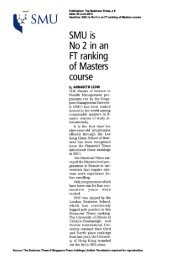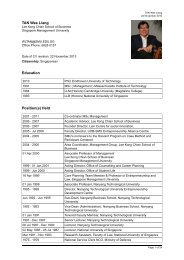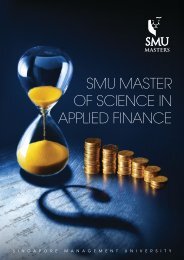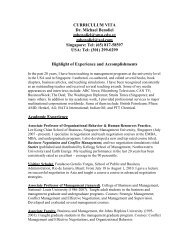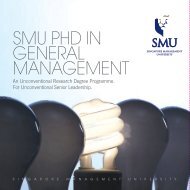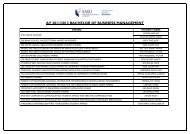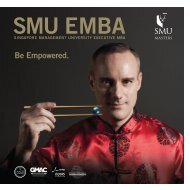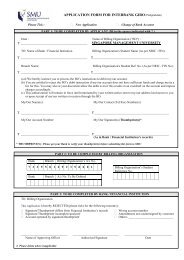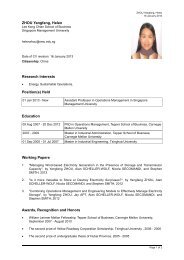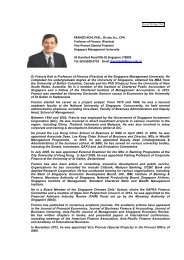Minh Long I Porcelain - Singapore Management University
Minh Long I Porcelain - Singapore Management University
Minh Long I Porcelain - Singapore Management University
You also want an ePaper? Increase the reach of your titles
YUMPU automatically turns print PDFs into web optimized ePapers that Google loves.
SMU-11-0008<br />
S<br />
MINH LONG I PORCELAIN CO. LTD.<br />
Cẩn tắc vô ưu.<br />
A Vietnamese Proverb: Translated: “Good watch prevents misfortune”<br />
It was April 2009 and Mr. Ly Ngoc, Chairman and CEO of Saigon-based <strong>Minh</strong> <strong>Long</strong> I <strong>Porcelain</strong><br />
Co. Ltd., just learned that Metro, a chain of seven department stores across Vietnam, had no<br />
intention of bringing the price of its porcelain pieces back up to the level that was agreed on in<br />
their sales and distribution agreement.<br />
<strong>Minh</strong> <strong>Long</strong> I <strong>Porcelain</strong> had always preserved good relations with their distribution channels. The<br />
company sold the majority of their domestic output through distributors who called upon<br />
Vietnams’ rapidly developing hospitality and retail segments. Distributors had their own sales<br />
teams, and also retained a series of external agents to sell their stock. The company maintained<br />
uniformed pricing throughout Vietnam and their distribution channels had always been willing to<br />
highlight the <strong>Minh</strong> <strong>Long</strong> I products. <strong>Minh</strong> <strong>Long</strong> I had always produced to the highest quality<br />
standards and their products commanded premium prices. While the company’s distribution<br />
margins were in-line with those of competing manufacturers the high prices translated into<br />
generous per unit margins for everyone in the channel. <br />
The global recession had created great uncertainty in Vietnam as banks tightened their lending<br />
practices. <strong>Minh</strong> <strong>Long</strong>’s sales team found that new customers were harder to come by and<br />
existing customers were timid in their purchases, postponing purchases to the last possible<br />
moment. Metro and several other retailers had begun to lower their prices below the agreed upon<br />
retail price in order to quickly move stock, boost cash flow and reduce risk. This was a clear<br />
violation of their agreement with the company, but these were not the easiest of times.<br />
Mr. <strong>Minh</strong> was concerned that the rift with Metro could lead to an ultimatum and the timing was<br />
certainly not optimal. He did not want to lose any points of distribution at this time, but he also<br />
knew that he needed resellers that wanted to add value to his products.<br />
This case was written by Philip C. Zerrillo PhD and Paolo Castadi at the <strong>Singapore</strong> <strong>Management</strong> <strong>University</strong>. The authors would also<br />
like to thank David Gertner Ph.D. for his insights. It was prepared solely to provide material for class discussion. The authors do not<br />
intend to illustrate either effective or ineffective handling of a managerial situation. The authors may have disguised certain names<br />
and other identifying information to protect confidentiality.<br />
Copyright 2011, P. Zerrillo, P.Castadi Version: 2011-19-10
The Vietnamese Economy<br />
The fall of Saigon (renamed Ho Chi <strong>Minh</strong> City in 1976) and the capitulation of the Army of the<br />
Republic of Vietnam in 1975 led to the country’s unification under the ruling of the Communist<br />
Party of Vietnam. Despite logistical support which the newly unified Vietnam received from<br />
China and the Soviet Union, the country found itself operating under dire economic conditions,<br />
which were exacerbated by US economic sanctions and trade embargo.<br />
As a consequence, beginning in the 1980s, the Vietnamese government was forced to relax<br />
restrictions on private enterprises and launched an economic renewal campaign (Doi Moi).<br />
Several social and economic reforms were introduced which de facto transformed Vietnam from<br />
a centralized economy to a socialist-oriented market economy. Eventually, after considerable<br />
negotiation, the government encouraged foreign investment and the establishment of private<br />
ventures. It also removed price controls on agricultural goods, which allowed farmers to sell their<br />
goods at real market prices, further boosting the economy.<br />
By the late 1990s, the results of the Doi Moi agricultural and business reforms were evident: the<br />
country was growing at a yearly rate of 7%. Though still a small part of the national economy,<br />
private sector growth was increasing at a multiple of its public counterpart. Thousands of new<br />
private enterprises were created every year and the poverty level, caused by four decades of wars,<br />
was reduced from 50% to roughly 29% of the adult population. In 2006 Vietnam finally became<br />
the 150 th member of the World Trade Organization, an event 11 years in the making. The<br />
country’s entry into The World Trade Organization (WTO) fueled an increase in Vietnam’s<br />
already remarkable domestic growth rate to 11% and a nominal GDP per capita of $1,218. Based<br />
on a Goldman-Sachs report, Vietnam was poised to reach a nominal GDP per capita of<br />
US$4,357 by 2025 and become the 17 th largest economy in the world.<br />
In 2001, the ruling Communist Party of Vietnam approved a 10-year economic reform plan<br />
which, paired with a previously signed Bilateral Trade Agreement with the USA, propelled<br />
Vietnam into a renewed period of growth, second only to China among WTO nations. The<br />
accompanying increase in consumer purchasing power and demand led to the establishment of<br />
many private enterprises in the restaurant and hospitality industry(Refer to Exhibit 3 for data on<br />
the growth of the hospitality industry). While the hospitality sector grew rapidly, government<br />
barriers to entry in the food retailing industry made foreign franchises shy away from the<br />
Vietnamese market. International fast food, hotel, and convenience store chains had limitations<br />
on the number of outlet permits that they would be granted, compromising their operational<br />
models. As a result, locally-owned restaurants, food shops and hotels began to grow throughout<br />
Vietnam.<br />
2/11
The ceramic and porcelain industry in Vietnam<br />
The art of making ceramics was originally brought to Vietnam around 1300 AD, though<br />
archeological estimates are not exact. Vietnam rapidly became known for manufacturing high<br />
quality ceramic and porcelain. Vietnamese craftsmanship, abundant deposits of high quality<br />
Kaolin, and the skillful combination of traditional styles with modern design elements were the<br />
fuel of the industry. The perfection of blue cobalt colored glazing in Vietnam changed the<br />
industry so much that by the 15 th century blue and white wares were the most popular in the<br />
world.<br />
Since its inception, the Vietnamese ceramic and porcelain industry had been highly fragmented,<br />
with small producers located in craft villages around the country. Lacking scale and<br />
sophistication, few producers had been able to afford the high-tech production equipment needed<br />
for the making of hard-paste porcelain, instead sticking to ceramic products.<br />
Vietnam’s government created barriers to entry that made it difficult for most foreign<br />
competitors to enter the Vietnamese ceramic and porcelain market. However, in 2004, several<br />
key foreign firms established a presence in Vietnam: CK and Ta Tung from Taiwan, and Giang<br />
Tay from Mainland China. These competitors did not have the technical capability of competing<br />
directly in the high quality segment with <strong>Minh</strong> <strong>Long</strong>, but rather focused on the mass markets.<br />
Giang Tay went out of business in 2007 and Ta Tung followed 18 months later. CK managed to<br />
remain afloat and slowly improved upon the quality of its porcelain products to become <strong>Minh</strong><br />
<strong>Long</strong>’s most serious competitor. The company sold to the trade with a recommended margin for<br />
the reseller of roughly 40%, but they were free to set their prices. Overall, CK prices were<br />
typically 40-70% below those of <strong>Minh</strong> <strong>Long</strong> I for smaller items and 40-50 % lower on large<br />
items such as vases and bowls. By 2011 CK had become even more price competitive.<br />
Data released by the Hanoi government showed that the ceramic industry in Vietnam was highlyexport<br />
oriented, with more than 50% of suppliers sending their entire output overseas. The US<br />
was the largest export market, accounting for in excess of 25% of total exports. Other important<br />
export markets were the EU, Japan and Korea.<br />
3/11
<strong>Minh</strong> <strong>Long</strong><br />
Company history<br />
At <strong>Minh</strong> <strong>Long</strong> I, the love for ceramics has been handed down for more than three generations.<br />
Mr. Ly Ngoc <strong>Minh</strong>’s paternal grandfather was born in Fujian, China and moved to the Binh<br />
Duong province in southern Vietnam where he lived for many years. Upon his death, he left<br />
<strong>Minh</strong>’s father several kilns. <strong>Minh</strong>’s father passed away when all of the children were still young.<br />
At 16 years of age, <strong>Minh</strong> became responsible for the kilns and the economic welfare of his<br />
family.<br />
He began to make porcelain, (Refer to Exhibit 1 for a summary of the porcelain making process)<br />
initially, for use in the electrical insulation business. Along with his brother Duong Van <strong>Long</strong> 1<br />
they founded the <strong>Minh</strong> <strong>Long</strong> company, built laboratories, created innovative designs and patterns,<br />
and found new recipes to make brighter (though more expensive) colors, eventually moving from<br />
insulation into chinaware and figurines. In 1971, in the middle of the USA-Vietnam war, the<br />
family business was booming and customers were shocked when they realized that two “20<br />
some-things” owned the <strong>Minh</strong> <strong>Long</strong> <strong>Porcelain</strong> Company (later to be renamed <strong>Minh</strong> <strong>Long</strong> I).<br />
The brothers built new kilns and increased capacity to satisfy an ever-growing demand for their<br />
products. While sales of insulation products were increasing, demand for figurines and vases<br />
with high quality textures and colors was experiencing explosive growth. <strong>Minh</strong> <strong>Long</strong>’s handpainted<br />
figurines were becoming highly sought after in foreign markets (which by this time<br />
generated the lion’s share of company sales.)<br />
While the company enjoyed great prosperity, there were bumps along the road. In the aftermath<br />
of the 1998 Southeast Asian recession and resulting trade policies, distribution channels were so<br />
disrupted that porcelain goods were virtually impossible to export. With little access to foreign<br />
markets the company was so restricted that Mr. <strong>Minh</strong> turned to farming until a close friend<br />
advised him: “The government now allows everyone to do business. You should return to<br />
making porcelain, because that’s who <strong>Minh</strong> <strong>Long</strong> is.” Upon <strong>Minh</strong>’s return to the business he<br />
established <strong>Minh</strong> <strong>Long</strong> I <strong>Porcelain</strong> Ltd., while his brother continued in the insulation business,<br />
operating the business as the <strong>Minh</strong> <strong>Long</strong> II company.<br />
Encouraged by the returning strength of company exports, Mr. Ly Ngoc <strong>Minh</strong> decided to focus<br />
on the domestic market and revive a Vietnam tableware industry which had been dominated by<br />
inferior quality Chinese goods. He started a domestic technological revolution, making what was<br />
widely regarded as the best quality porcelain in Southeast Asia. The company developed new<br />
1<br />
Five years later, Mr. Ly Ngoc <strong>Long</strong> spun off a second company called <strong>Minh</strong> <strong>Long</strong> 2 that to this day builds porcelain electric insulators.<br />
4/11
firing techniques and were able to achieve a brilliant array of colors,<br />
facilitating their ability to find the perfect color to suit each product.<br />
Between 1990 and 1998, Mr. <strong>Minh</strong> spent a considerable amount of time in Europe, where he<br />
learned emerging techniques for making higher quality porcelain. Additionally, during his time<br />
in Europe, he gained insight into the market needs of Europeans, and forged solid distribution<br />
arrangements. As a result of his efforts, new orders from the French and German markets<br />
brought a steady 10% yearly revenue growth.<br />
Always a family business, Mr. <strong>Minh</strong>’s children grew up around the factory floor and the<br />
showroom shops. Starting in 2001, Mr. <strong>Minh</strong> rearranged his company’s management structure to<br />
include his three elder children into the nucleus of corporate leadership.<br />
As 2009 began, <strong>Minh</strong> <strong>Long</strong> was the largest producer of high-quality porcelain in Vietnam, with<br />
roughly 2,200 full-time employees, production of 35 million pieces per year and annual sales in<br />
excess of US$15 Million (Refer to Exhibit 2 for historical financial sales of <strong>Minh</strong> <strong>Long</strong>). By<br />
comparison, the next largest porcelain-maker, by size, Hai Duong, was state-owned and heavily<br />
subsidized, with 500 full-time employees, a production of 12 million piece/year and annual sales<br />
of US$4 Million, across all of its product categories.<br />
<strong>Minh</strong> <strong>Long</strong>’s Market Approach<br />
<strong>Minh</strong> <strong>Long</strong> had two main product lines: tableware and figurines. Tableware and cookware<br />
production at <strong>Minh</strong> <strong>Long</strong> started in 1996 and it eventually became the company’s main focus as<br />
domestic demand from restaurants and hotels grew. Tableware also had a 30% higher<br />
profitability margin than figurines.<br />
Hand painted figurines had always been positioned for export markets, which comprised nearly<br />
75% of total figurine sales. With low labor rates compared to France and the natural trade ties<br />
between Vietnam and France, the company began selling to the French market beginning in the<br />
mid 1970s. Figurines were being affected by increasing labor, distribution and sales expenses<br />
leading to lower margins than tableware, slowly marginalizing their importance in the company<br />
portfolio. In 2008, 97% of company exports, mainly to France and Germany, were figurines.<br />
Distribution in Vietnam was logistically very complex as nearly three quarters of the country’s’<br />
85 million plus population lived in rural areas. AT Kearney estimated that Vietnam had over<br />
500,000 traditional shops selling consumer packaged goods. Despite the 2008 economic<br />
downturn the segment was witnessing 16% year-on-year same store sales growth. Even more<br />
5/11
impressive, the number of modern trade outlets looked as though it would grow 45% in 2009,<br />
and per store sales were increasing at over 65% yearly. 2<br />
<strong>Minh</strong> <strong>Long</strong> sold 20 million pieces of tableware and cookware in 2008, with its volume steadily<br />
increasing in the years 2002 to 2008. Overall gross profit margins were roughly 30% (Refer to<br />
Exhibit 4 for a breakdown of <strong>Minh</strong> <strong>Long</strong>’s tableware and cookware cost structure.)<br />
<strong>Minh</strong> <strong>Long</strong> distributed through its three national distributors, geographically located in Hanoi<br />
(North), Ho Chi <strong>Minh</strong> City (South) and Danang (Central Vietnam). A fourth distributor was<br />
dedicated to the international market. The three domestic distributors comprised 48% of the<br />
company’s domestic sales dollars. Additionally, there were a series of regional distributors that<br />
provided coverage in confined rural areas and constituted 11% of volume and 8% of domestic<br />
revenues. The company’s internal sales force made up the remaining volume, as they maintained<br />
direct relations with select customers and serviced the distributors. Distributor profitability was<br />
not easily tracked, but it was believed that net profitability was roughly 3-5%.<br />
<strong>Minh</strong> <strong>Long</strong> I distributors were contractually obligated to maintain specified resale prices when<br />
selling to agents, hospitality and retail customers. The company constructed a program discount<br />
schedule for their national distributors. Typically, distributors worked off of a set margin of 30-<br />
40% (depending on lines and product classes), but if they kept a show room, met standards<br />
regarding its layout and design, stocked product, created sales materials, and met their sales<br />
targets they could receive margins in excess of 37% for even the lowest margin products.<br />
Retailers were required to maintain uniformed prices as well. Distributors were contractually<br />
obligated to monitor their retail accounts. Retailers caught selling products below the company’s<br />
stated price levels faced termination.<br />
<strong>Minh</strong> <strong>Long</strong> I also sold directly to large clients, whose agents contacted the company and<br />
therefore bypassed the distributors. In such cases, <strong>Minh</strong> <strong>Long</strong> sold to the agent at the same price<br />
they would have bought it from the distributor and reimbursed the bypassed distributor for the<br />
missed profit (about 3%).<br />
<strong>Minh</strong> <strong>Long</strong> I’s uniformed pricing policy had implications for their distribution channel. A<br />
distributor who bought the product from <strong>Minh</strong> <strong>Long</strong> I could sell it to the end users (e.g., hotels<br />
and restaurants) through its stores for a 40% mark-up from manufacturer price, or sell it to an<br />
agent at a 21% mark-up. Agents were required to sell at the same final sales price to end<br />
customers or risk being dropped.<br />
2<br />
(http://blog.nielsen.com/nielsenwire/consumer/vietnams-robust-retail-scene/).<br />
6/11
Storm Clouds Gather<br />
Mr. <strong>Minh</strong> had to rely on his distributors to help distinguish his products in the marketplace.<br />
While <strong>Minh</strong> <strong>Long</strong> I quality was apparent to the expert, the consumer did not always recognize it.<br />
Consumers didn’t know what to look for when buying porcelain products, as these were not<br />
frequent purchases.<br />
The company had set up two showrooms where they showcased porcelain dinnerware sets and<br />
artistic collection items. The company’s special collection of giant vases and the world’s largest<br />
kiln fired cup were testaments to their manufacturing and artistic prowess. The showrooms were<br />
intended to serve as an example for distributors on how to best display and market <strong>Minh</strong> <strong>Long</strong> I<br />
products. However, distributors were hesitant to bring new wholesale customers to the<br />
company’s showrooms. <strong>Minh</strong> <strong>Long</strong>’s distributors were also pressing Mr. <strong>Minh</strong> to decrease<br />
manufacturer prices to the trade so that they could either profit more on the established selling<br />
price or potentially lower prices.<br />
Metro department stores did not represent <strong>Minh</strong> <strong>Long</strong>’s only discounting issue. Nguyen Kim, a<br />
chain of electronics and home furnishing department stores had also recently lowered prices.<br />
These two accounts together represented 4 and 5% of company sales respectively. <strong>Minh</strong> had<br />
created <strong>Minh</strong> <strong>Long</strong> forty years ago with the goal of producing the best quality porcelain in<br />
Southeast Asia. He had put his family’s name on the products and that was all the more reason to<br />
strive for greatness. He needed to protect the family name, but he wondered what the value was<br />
if he could not sell the goods he manufactured.<br />
It was becoming clear to Mr. <strong>Minh</strong> that the price issue with Metro and Nguyen Kim stores was<br />
only the tip of the iceberg. The larger issue at stake was that the ever-increasing number of<br />
retail outlets purchasing <strong>Minh</strong> <strong>Long</strong> porcelain products had begun to make individual store price<br />
checking cumbersome, if not impossible. Also, Mr. <strong>Minh</strong> had to listen to his distributors’<br />
demands for higher profits but he was uncertain whether simply raising the prices of his product<br />
was the solution in this economy.<br />
7/11
EXHIBITS<br />
Exhibit 1 – The Making of <strong>Porcelain</strong><br />
<strong>Porcelain</strong> is a ceramic material that has been baked at temperatures between 1,200 and 1,400 °C<br />
until it obtains a glassy state characterized by its well known translucence, low porosity and<br />
hardness. The term porcelain derives from the Italian word for a type of shell “porcellana” that<br />
can be found on the Mediterranean coastline. <strong>Porcelain</strong> has several types of applications such<br />
as tableware, chemical ware, figurines, dental crowns and electric insulators. There are two main<br />
types of porcelain: soft-paste and hard-paste.<br />
Soft-paste porcelain is made from a mixture of kaolin clay and powdered glass (frit). Soft-paste<br />
porcelain cannot withstand very high temperatures as it tends to warp and lose shape. Soft-paste<br />
porcelain was first made in Europe three centuries ago, in an attempt of reproducing its hardpaste<br />
counterpart from South Asia. For that reason, soft-paste porcelain has been dubbed China,<br />
but it is in fact a misnomer.<br />
The higher quality hard-paste porcelain, such as that produced by <strong>Minh</strong> <strong>Long</strong> I, is made from a<br />
mixture of kaolin clay, quartz and feldspar. <strong>Minh</strong> <strong>Long</strong> I management sources its clay from<br />
countries providing the best choice of raw materials, such as New Zealand, China, United<br />
Kingdom, India, Russia, Canada and the US. The clay is crushed and milled to remove<br />
impurities, before being mixed with quartz and feldspar at three different levels of moisture:<br />
powder, clay paste and gel.<br />
Powder is used for the simplest of tableware items such as dishes. With this technique, the clay<br />
powder is shaped at high pressure between resin molds. For more delicate shapes, such as cups,<br />
pots or embossed objects, clay paste, with its higher plasticity is used instead. The clay paste is<br />
spun at high speeds and molded into the desired shape. For non-cylindrical shapes a clay gel at<br />
higher moisture content is poured by hand into a plaster mold or a robot can also be used for very<br />
large objects such as large odd-shaped platters.<br />
Once unfired items are formed, odd components such as spouts and handles are attached before<br />
being glazed. Glazing not only improves hardness, but also serves decorative purposes such as<br />
coloring (bisque is the natural color of porcelain), but also makes porcelain stain resistant.<br />
<strong>Porcelain</strong> glaze is made from the same raw materials as the main body, although in different<br />
amounts.<br />
Glazed items are then baked in a large kiln. At <strong>Minh</strong> <strong>Long</strong> I, the baking process lasts 7 hours and<br />
reaches a temperature of 1,380 °C at which all the impurities in the clay evaporate and the silica<br />
in the clay rearranges itself into liquid glass. It should be noted that besides <strong>Minh</strong> <strong>Long</strong> I, no<br />
other porcelain manufacturer, with the exception of a few high quality EU producers, are able to<br />
fire porcelain at such a high temperature. As the clay slowly cools down, the material solidifies<br />
8/11
into porcelain, a glassy translucent, smooth and very hard material. In order to qualify for highgrade<br />
hard-paste porcelain, water content must be lower than 0.05%.<br />
When the fired items exit the kiln, they are cooled off to room temperature before being branded<br />
with the <strong>Minh</strong> <strong>Long</strong> logo and quality inspected and decorated using paints that in certain designs<br />
can contain noble materials such as gold and platinum. For large decorations, such as the band<br />
around the body of a plate, a decal is used instead. Once the decoration is complete, the item is<br />
refired at a slightly lower temperature (about 1,250 °C), so that the paint and decals are<br />
embedded into the surface of the porcelain.<br />
9/11
Exhibit 2 – <strong>Minh</strong> <strong>Long</strong> Historical Sales Volume<br />
Domestic <br />
Export <br />
Source: <strong>Minh</strong> <strong>Long</strong><br />
Year <br />
Exhibit 3 – Hotel and Restaurant Sales in Vietnam<br />
120,000 <br />
Annual Sales (Billion Dong) <br />
100,000 <br />
80,000 <br />
60,000 <br />
40,000 <br />
20,000 <br />
0 <br />
1990 <br />
1991 <br />
1992 <br />
1993 <br />
1994 <br />
1995 <br />
1996 <br />
1997 <br />
1998 <br />
1999 <br />
2000 <br />
2001 <br />
2002 <br />
2003 <br />
2004 <br />
2005 <br />
2006 <br />
2007 <br />
2008 <br />
Source: General Statistics Office of Vietnam<br />
10/11
Exhibit 4 – Company’s cost structure*<br />
DepreciaEon <br />
of Capital <br />
5% <br />
Raw <br />
Materials <br />
6% <br />
Other Cost of <br />
Goods Sold <br />
14% <br />
Gross Margin <br />
30% <br />
Energy <br />
10% <br />
Labour <br />
35% <br />
*Cookware and dinnerware product line<br />
Source: <strong>Minh</strong> <strong>Long</strong><br />
11/11



